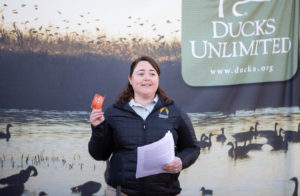CWD Update – Core Zone Expanded in Southern Michigan
This from MUCC…
At one of the CWD meetings the DNR held in Ionia, Both Chad Stewart and Chad Fedewa gave presentations on the disease, and what the Division has done to understand the spread of the disease at this time. Around 30 people attended the meeting, and at least five deer cooperatives were represented.
Chad Stewart provided an overview of the disease. CWD is always fatal; once a deer gets the disease, it will die from it, unless something else kills it first. Deer can live with the disease for 18-24 months before showing any signs of having the disease, and can live up to five years with it. All deer are susceptible to getting the disease, but males are more commonly affected. CWD is not known to be transferrable to humans. This disease is similar to that of Mad Cow disease. About 200 people died after consuming meat contaminated by Mad Cow, but millions were exposed to the contaminated meat. This being said, while it is not known to transfer, that is not to say it couldn’t happen.
If you live in the CWD Counties (see map below), it is suggested you take your deer in to be tested. If you live in the core townships within those counties (see map below), it is REQUIRED that you get your deer tested. CWD can be transmitted directly and indirectly. CWD can be spread via urine, fecal matter, and saliva of a sick deer to another deer, either via direct contact, or the excretions being on a plant, bait pile, rub, another deer makes contact with. Once inside the body, the prions (what CWD is made of) begin to multiply. EHD (epizootic hemorrhagic disease) is another disease hunters in Michigan are familiar with.

Below is a list of differences between EHD and CWD.
EHD – virus, fast acting, mostly fatal, transfers bug to deer, late summer/early fall, population affected quickly, population can recover quickly (4-6 years)
CWD – prions, long lived, always fatal, transfers deer to deer, all year, population affected slowly, long term impacts unknown
The goal here in Michigan is to target the deer hard within a two mile radius of where a confirmed positive case was found. The hope is that any other sick deer can be killed before they spread the disease further.
Chad Fedewa provided an update on what DNR has done since the first CWD positive deer was found in a captive facility in Kent County in 2008. Despite an intense surveillance, no additional deer were found with CWD until the spring of 2015. The first wild deer found with CWD here in Michigan was a six year old female, carrying twins. The doe was taken out by the Meridian Township Police after a call was made about a very sick looking deer. This is the only deer that was found to be CWD positive that showed visible symptoms of being sick. Two additional hunter harvested deer were found CWD positive, and four deer harvested by sharpshooters were found positive; bringing the total CWD count since 2015 to seven deer with confirmed CWD.
DNR created a CWD response plan in 2002 in response to Wisconsin finding CWD in their deer herd. The plan was updated in 2012 with a focus on the following items, should CWD be found in Michigan: Conduct a population survey, create a CWD management zone, implement a bait ban, and prohibit the movement of deer outside of the CWD management zone.
The CWD core zone (17 township area, see map above) has added restrictions including: Required deer check, a restriction on the transport of deer carcass, it is not legal to more roadkill deer, no APR on the second buck tag, in addition, there is not baiting or feeding in any of the CWD Counties (see map above).
Numbers of deer tested in the CWD core area:
-1040 hunter harvested deer checked
-1080 roadkill deer checked
-796 sharpshot deer
At least we have some good news. CWD levels appear to be low, and there is not any indication that this disease has been here long. Let’s do our part as hunters and stewards and provide data, and understand the disease and its management implications.
For additional information, please visit: www.mi.gov/cwd
Notes about sharpshooters: They only kill deer where they have permission. If they are shooting deer on private land, they have permission, and the landowner has told them how many deer, what sex. The land owner has complete say over the number and types of deer taken by the USDA.
Note to out of state hunters: Make sure you know which states have CWD. There are regulations on what parts of the deer can be brought into Michigan from CWD positive states. The numbers of states with CWD are on the increase.






